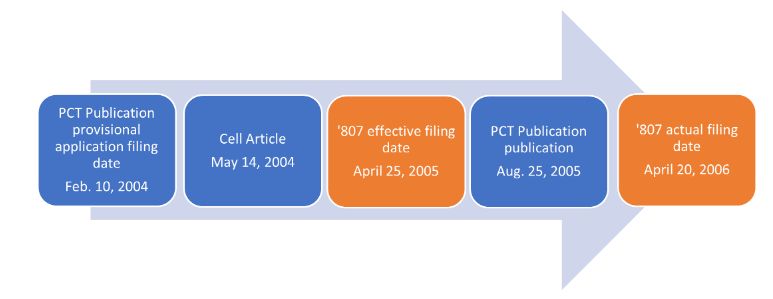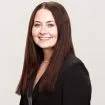Holding:
In Thorne Research, Inc. v. Trustees of Dartmouth College, IPR2021-00491, Paper 48 (P.T.A.B. Aug. 10, 2022), the challenged claims of U.S. Pat. No. 8,197,807 ("the '807 patent") survived. The Patent Trial and Appeal Board ("the Board") issued a Final Written Decision ("FWD") holding no challenged claims unpatentable.
Background:
Thorne filed a petition for inter partes review ("IPR") and challenged claims 1-3 of the '807 patent as unpatentable for being anticipated and obvious. Thorne relied upon a Cell article for the obviousness ground and a PCT Publication for the anticipation ground. The Cell article was published on May 14, 2004, and the PCT Publication occurred on August 25, 2005, but the PCT claimed priority to a provisional application filed February 10, 2004. The diagram below depicts the timing of these events relative to the alleged effective filing date and actual filing date of the '807 patent.

Patent Owner argued that the Cell article and PCT Publication were not prior art to the '807 patent. Id. at *9. According to the Patent Owner, the '807 patent was entitled to an effective filing date of April 25, 2005, via a claim to priority under 35 U.S.C. §120 to the April 25, 2005, filing date of U.S. Application No. 11/113,701 ("the '701 application"). Based on this effective filing date, Patent Owner argued the Cell article was not prior art under 35 U.S.C. § 102(b), and that the cited references only qualified as prior art under 35 U.S.C. §§102(a) or 102(e). Patent Owner also argued that none of the asserted references were "by another," as required by 35 U.S.C. §102(a) or § 102(e), and therefore cannot be prior art to the '807 patent. Id.1
Petitioner argued that the '807 patent was only entitled to an effective filing date of April 20, 2006, which was the actual filing date of the application that led to the '807 patent. Id. at *9-10. Therefore, the Cell article was available as prior art under 35 U.S.C. §102(b) because its publication date of May 14, 2004, was more than one year before April 20, 2006. Id. at *9. Petitioner also argued the PCT Publication was prior art either under 35 U.S.C. §102(a), based on its August 25, 2005, publication date or under 35 U.S.C. § 102(e), based on its February 10, 2004 provisional application filing date. Id.; see also Petition at 34-35 n. 12.
Board: The Board found the specification of the '807 patent clearly claimed priority back to the '701 application and the '807 patent was entitled to an effective filing date of April 25, 2005. Id. at *12.
Since the Cell article was published May 14, 2004, it qualified as prior art under 35 U.S.C. §102(a) if it was "by another." Id. at *14. Likewise, the PCT Publication, published August 25, 2005, qualified prior art under 35 U.S.C. § 102(a) or (e) if it disclosed work "by another."
On their face, the references listed different inventive entities compared to the '807 patent: the PCT Publication listed Dr. Brenner and Dr. Bieganowski as co-inventors, and the Cell article listed Dr. Brenner and Dr. Bieganowski as co-authors, but the '807 patent listed Dr. Brenner as the sole inventor. Id. at *16.
The inquiry turned on whether the portions of the references relied upon by Petitioner represent the sole work of Dr. Brenner. Id. Patent Owner submitted declarations from Dr. Brenner and Dr. Bieganowski supporting the argument that the work reflected in the Cell article and the PCT Publication represented solely that of Dr. Brenner. Id. at *16-19; 32. The Board was persuaded that Patent Owner met its burden of production and found that Petitioner's rebuttal failed to show the Cell article or PCT Publication qualified as prior art. Id. at *19-30; 32.
With respect to the PCT Publication, Petitioner argued:
[T]he testimony regarding Dr. Brenner being the sole inventor of the relied-upon portions of the PCT Publication is contradicted by the fact that Drs. Brenner and Bieganowski were both listed as inventors on the PCT Publication and on the earlier filed provisional application, US App. No. 60/543,347. Id. ...Dr. Brenner checked both of these applications to be sure they were accurate, including with regard to inventorship...[and] this is inconsistent with Dr. Brenner's declaration, where he claims to be the sole inventor of the subject matter disclosed and claimed in the PCT Publication.
Id. at *32-33.
The Board rejected this argument. Id. at *33.
Although the listing of Dr. Bieganowski on the provisional application and the PCT Publication suggests that Dr. Bieganowski may have contributed in some manner to the invention described in one or more of the claims in those documents, it does not show that Dr. Bieganowski contributed to the relied-upon portions of the PCT Publication. . . . Given the corroborated testimony of Dr. Brenner that he is the sole inventor of the relied upon portions of the references, Dr. Bieganowski's unequivocal disclaimer of the inventions, and a lack of other evidence suggesting that Dr. Bieganowski made any contribution to the relied-upon portions of the references, we decline to make any inference based on Dr. Bieganowki having been listed as a co-inventor on the PCT Publication or any of the applications leading up to the '807 patent.
Id. at *33-34. Accordingly, because the '807 patent was entitled to its alleged priority date, and because the portions of the cited references relied upon by the Petitioner were not the work of "another," the Board concluded that the Petitioner had not met its burden of proving the claims unpatentable.
Takeaways
Consider Thorne in the context of another recent opinion, LSI Corp. v. Regents of the Univ. of Minnesota, No. 21-2057 (Fed. Cir. 2022). In LSI, the Federal Circuit affirmed the holding of the Board in IPR2017-01068 that, inter alia, the asserted reference, Tsang, did not anticipate claims 14 and 17 of U.S. Pat. No. 5,859,601 ("the '601 patent"). In particular, the Board held that Tsang was not prior art because the portions relied upon were not "by another" under 35 U.S.C. §102(e).
Tsang listed a single inventor, Dr. Tsang, while the '601 patent listed two inventors, Drs. Moon and Brickner. Patent Owner argued the portions of Tsang relied on by the Petitioner were not by "another" because they had been disclosed in another reference, the Seagate Annual Report, prior to the effective filing date of the '601 patent. Id. at *4. And the Seagate Annual Report listed Drs. Moon and Brickner as the only authors.
The Board agreed with the Patent Owner, finding that the Petitioner's Tsang-based arguments only relied on material disclosed in the Seagate Annual Report. Thus, the Petitioner had "not satisfied its burden to prove the portions of Tsang relied upon for anticipation represent the work of another to qualify as prior art under § 102(e)." Id.at *8.
On appeal, the Federal Circuit conducted the three-step analysis set out in Duncan Parking Techs., Inc. v. IPS Grp., Inc., 914 F.3d 1347, 1358 (Fed. Cir. 2019), noting:
[T]he Board must (1) determine what portions of the reference patent were relied on as prior art to anticipate the claim limitations at issue, (2) evaluate the degree to which those portions were conceived "by another," and (3) decide whether that other person's contribution is significant enough, when measured against the full anticipating disclosure, to render him a joint inventor of the applied portions of the reference patent.
Id. at *11.
The court noted that although the Tsang patent may be prior art on its face to the '601 patent because Dr. Tsang is the only listed inventor and is not a listed inventor on the '601 patent, the "question is whether the invention of Tsang was relied upon and relevant to anticipation, or whether it was simply Tsang's summary of the earlier Seagate Annual Report that was relied upon and relevant to anticipation. Tsang's summary of, and reliance on, the earlier work of Dr. Moon and Dr. Brickner does not make Tsang an inventor of the earlier work." Id. at *11 (emphasis added).
The Federal Circuit found that the petition relied on portions of the Seagate Annual Report and portions of Tsang's specific invention. Id. at *12. But the Tsang-specific material was not relevant to anticipation. Id. The disclosure based on the Seagate Annual Report and repeated in the Tsang patent was the relevant information relied upon for the anticipation challenge, and therefore Tsang did not qualify as "by another." Id. at *13. The Federal Circuit affirmed the Board's finding of no anticipation based on Tsang. Id. at *14.
Take Aways: These cases serve as a good reminder to patent owners that knocking out the asserted prior art status of a reference can be a valuable strategy in an IPR. It may require some detailed analysis as to what exact disclosure in the asserted reference is being relied upon and then careful consideration of attribution. This may involve searching for evidence such as letters, invoices, patent applications, and articles to provide corroboration to testimony, if sufficiently verified. Lessons from cases discussing the types of proof required for showing inventorship may be helpful in this regard.
Footnote
1. 35 U.S.C. 102 (pre-AIA) Conditions for patentability; novelty and loss of right to patent.
A person shall be entitled to a patent unless -
(a) the invention was known or used by others in this country, or patented or described in a printed publication in this or a foreign country, before the invention thereof by the applicant for patent, or
(b) the invention was patented or described in a printed publication in this or a foreign country or in public use or on sale in this country, more than one year prior to the date of the application for patent in the United States, or
......
(e) the invention was described in - (1) an application for patent, published under section 122(b), by another filed in the United States before the invention by the applicant for patent or (2) a patent granted on an application for patent by another filed in the United States before the invention by the applicant for patent, . . . ;
The content of this article is intended to provide a general guide to the subject matter. Specialist advice should be sought about your specific circumstances.



